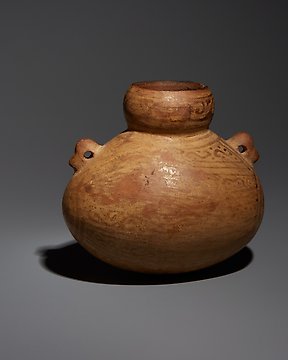
Chancay, Perú Terracotta Bowl. 900-1400 AD. 8.5 cm Height. Spanish Export License. (No Reserve Price)
No. 84324797

No. 84324797

Important cupisnique bottle of the best style, with extremelly rare figurative incised decoration.
Of the finest style!
- Thermoluminiscense Test -
CULTURE: Cupinsique, Perú
PERIOD: 800–550 BC
MATERIAL: Terracotta
DIMENSIONS: Height 17 cm
CONDITION: Good condition.
PROVENANCE: Private collection, Paris, France. 1970.
DOCUMENTATION: Spanish Import license included.
DESCRIPTION:
Huacos are closed vessels with a spherical or sculpted body, a flat base and a tubular handle in the form of a stirrup. They have been and are one of the principal elements which allow us to know not only characteristics of this pre-Hispanic culture, but also of its society, the natural environment in which it developed and the different stages of its cultural evolution. Its name derives from huaca, the name referring to a tomb of this culture, as moreover, these vessels were destined to make up part of the grave goods of a deceased person.
The Chavín culture represents the consolidation of several long-term cultural processes in the Andes, such as the invention of ceramics and of agriculture, village life, and monumental architecture. The dissemination of the Chavín artistic style, mainly through textiles and ceramics, followed the spread of their influential religious ideas, and extended from Chongoyape in the north all the way to Ica and Ayacucho in the south. This tradition can be said to have provided the cultural foundation of many societies that arose in the Andes in later periods. Some authors maintain that Chavín de Huántar continued to function as a pilgrimage site until the arrival of the Spanish.
The Chavín culture is named after the archaeological site Chavín de Huántar, located in a fertile valley in the north-central Andes of Peru, at an altitude of 3135 meters (10,285 feet) above sea level.
The word ‘Chavín’ also refers to an artistic style characterized by the use of symmetry, repetition, curved lines, metaphorical imagery, and motifs such as crossed fangs, the “eccentric eye”, dilated nostrils, and claws. Much of the intricate, stylized imagery employed in the Chavín style was inspired by the flora and fauna of the Amazon rainforest, such as crocodiles, felines, snakes, eagles, and plants. This style was expressed in different media and generally with a high degree of complexity. It reached its highest expression in Chavín’ stonework, such as enormous temples and sculpted standing stones and obelisks with figures that are half man, half feline, including the Lanzón, the Estela Raimondi, and the Obelisco Tello. This preference for working in stone is also reflected in Chavín pottery, which is unmistakably stone-like in appearance, grayish in color and decorated by incision. Like the stonework, Chavín’ ceramics are remarkable for their outstanding technical quality, as well as an emphasis on shaped decorations and, in a few exceptional pieces, the application of colored pigments. Types of vessels include fruit-shaped bottles with stirrup handles, bowls, and simple bottles.
Notes:
The seller guarantees that he acquired this piece according to all national and international laws related to the ownership of cultural property. Provenance statement seen by Catawiki.
The seller will take care that any necessary permits, like an export license will be arranged, he will inform the buyer about the status of it if this takes more than a few days.
The piece includes authenticity certificate.
The piece includes Spanish Export License.
How to buy on Catawiki
1. Discover something special
2. Place the top bid
3. Make a secure payment